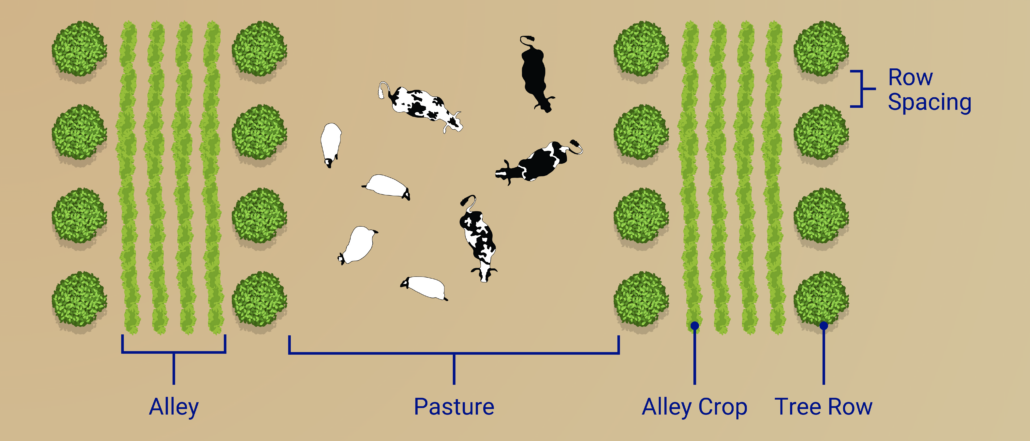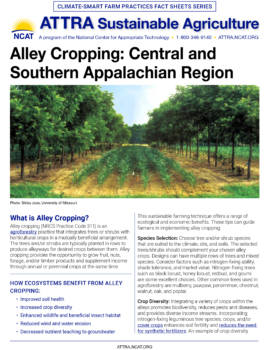Alley Cropping: Central and Southern Appalachian Region

Photo: Shibu Jose, University of Missouri
CLIMATE-SMART FARM PRACTICES FACT SHEET SERIES
By Danielle Crocker, NCAT Agriculture Specialist
What Is Alley Cropping?
Alley cropping (NRCS Practice Code 311) is an agroforestry practice that integrates trees or shrubs with horticultural crops in a mutually beneficial arrangement. The trees and/or shrubs are typically planted in rows to produce alleyways for desired crops between them. Alley cropping provides the opportunity to grow fruit, nuts, forage, and/or timber products and supplement income through annual or perennial crops at the same time. This sustainable farming technique offers a range of ecological and economic benefits.
How ecosystems benefit from alley cropping:
- Improved soil health
- Increased crop diversity
- Enhanced wildlife and beneficial insect habitat
- Reduced wind and water erosion
- Decreased nutrient leaching to groundwater
These tips can guide farmers in implementing alley cropping:
Species Selection
Choose tree and/or shrub species that are suited to the climate, site, and soils. The selected trees/shrubs should complement your chosen alley crops. Designs can have multiple rows of trees and mixed species. Consider factors such as nitrogen-fixing ability, shade tolerance, and market value. Nitrogen-fixing trees such as black locust, honey locust, redbud, and goumi are some excellent choices. Other common trees used in agroforestry are mulberry, pawpaw, persimmon, chestnut, walnut, oak, and poplar.
Crop Diversity
Integrating a variety of crops within the alleys promotes biodiversity, reduces pests and diseases, and provides diverse income streams. Incorporating nitrogen-fixing leguminous tree species, crops, and/or cover crops enhances soil fertility and reduces the need for synthetic fertilizers. An example of crop diversity might be a system that incorporates chestnut, pawpaw, and elderberry as the tree/shrub component. The crops planted between the tree/shrub alley may be one species or a combination of species. Examples include vegetables, flowers, or herbs.
Spatial Arrangement
Plan the rows or layout of trees and/or shrubs with alley crops to maximize your target light exposure, nutrient cycling, and water-use efficiency. Consider contour planting on sloping areas and filter strips close to any bodies of water. Ensure accessibility to accommodate management practices such as pruning, harvesting, spraying, and moving equipment.
Water Management
Design alley cropping systems to enhance water retention in the soil, in order to prevent erosion and optimize water-use efficiency. Mulching and/or drip irrigation are ideal options for optimizing water.
Crop Management
Management will change over time as trees and shrubs grow. Implement regular pruning of trees and shrubs to optimize light penetration and encourage efficient nutrient cycling. The alley crops grown may need to change over time, as the trees/shrubs grow.
Economic Benefits
Evaluate the economic potential of alley cropping by considering market demand for both tree products and alley crops. Economic benefits and management may change over time. Simultaneously planning for short-term and long-term goals is an ideal practice when alley cropping.
Soil Benefits
Healthy soils have high levels of microbial activity, high levels of organic matter, and good soil structure. Trees and shrubs contribute organic matter from tree litter, and microbial activity increases due to additional tree litter. Soil structure also improves with the combination of tree/shrub organic matter and sub-soil roots.
Climate Resilience
Trees and shrubs capture carbon dioxide from the atmosphere and store it in their biomass. Alley cropping can help sequester additional carbon in agricultural systems by integrating trees and/or shrubs. Enhance the resilience of farming systems to climate change by employing the impacts of trees on temperature (shade) and providing additional, diverse income sources.

Alley-cropping system example. Graphic: NCAT
Conclusion
Alley cropping presents a promising avenue for sustainable agriculture, providing a balance between productivity and environmental conservation. Compared with monoculture systems, alley cropping can provide increased land-use efficiency, increased economic diversity, and higher overall farm yield. Farmers adopting these practices contribute not only to their own prosperity but also to the broader goal of building resilient and sustainable food systems. To learn more about this practice, contact ATTRA.
Further Resources
Alley Cropping. 2021. Chapter 3. In Training Manual for Applied Agroforestry Practices. By University of Missouri Center for Agroforestry.
Alley Cropping. No date. By USDA Forest Service.
Alley Cropping. No date. By USDA Natural Resources Conservation Service.
Designing a Coffee and Avocado Alley Cropping System. 2022. By ATTRA.
Quick Tips for Agroforestry. 2023. By Katherine Favor, ATTRA
Alley Cropping: Central and Southern Appalachian Region
By Danielle Crocker, NCAT Agriculture Specialist
Published February 2024
©NCAT
IP653
This publication is produced by the National Center for Appropriate Technology through the ATTRA Sustainable Agriculture program, under a cooperative agreement with USDA Rural Development. This publication was also made possible in part by funding from the Partnership for Climate-Smart Commodities Grant-Building Soils, Building Equity, as administered by the USDA, grant # NR233A750004G024. ATTRA.NCAT.ORG

